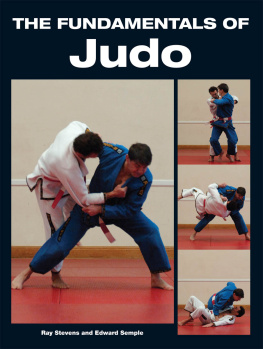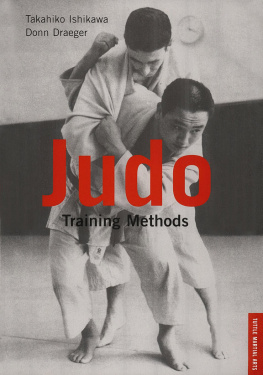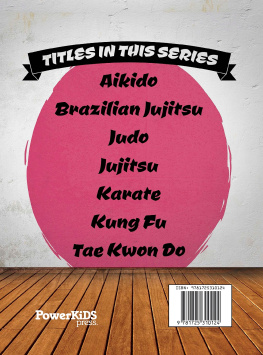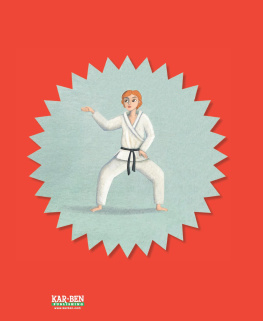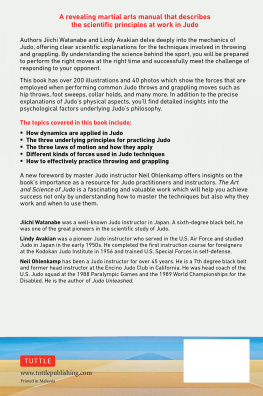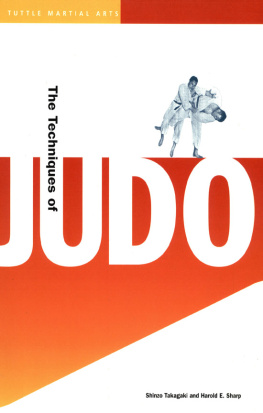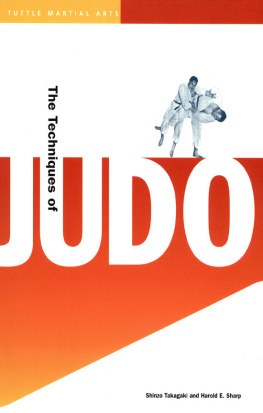
THE FUNDAMENTALS OF
Judo
Ray Stevens and Edward Semple

THE CROWOOD PRESS
First published in 2012 by
The Crowood Press Ltd
Ramsbury, Marlborough
Wiltshire SN8 2HR
www.crowood.com
This e-book first published in 2014
Ray Stevens and Edward Semple 2012
Photographs Patrick Jackson
Illustrations Hilary Walker
All rights reserved. No part of this publication may be reproduced or transmitted in any form or by any means, electronic or mechanical, including photocopy, recording, or any information storage and retrieval system, without permission in writing from the publishers.
British Library Cataloguing-in-Publication Data
A catalogue record for this book is available from the British Library.
ISBN 978 1 84797 918 6
CONTENTS
DEDICATION
This book is dedicated to Elvis Gordon. May you rest in peace my friend.
ACKNOWLEDGEMENTS
The authors extend their sincere thanks to Hilary Walker who drew the illustrations to this book and proof read the text. Her input has simply been invaluable. Hilarys website is a must for anyone who likes the illustrations in this book www.hilarywalker.co.uk. Hilary was given permission to observe and photograph a black belt training session at the Kodokan Dojo in Tokyo, Japan. The images she took away from that visit inspired the illustrations in this book. Patrick Jackson took the photos for the book and the authors would like to thank him for his incredible patience and support.
Photographs Patrick Jackson
www.patrickjacksonimages.com
Illustrations Hilary Walker
Illustrations by Hilary Walker are available for purchase as prints from
www.hilarywalker.co.uk
FOREWORD
Among British judoka Ray Stevens stands out as one of those who have done more than most to make the sport of judo better known and accessible to a wide audience. His achievements in judo are well known: an Olympic Silver Medallist who has trained and competed successfully in many parts of the world, he is now Vice-Chairman of the London Area.
Rays passion for judo started at a young age when his focus and determination soon became apparent. Having had the privilege of observing his career over many years, I was delighted to learn that he had decided to present his skills, experience and judo insights in a new book. Ray is a popular and accomplished teacher and his fresh and engaging style, accompanied by his sound techniques, will appeal to beginners and the more experienced practitioner alike.
Judo is a sport that never stands still: as well as re-interpreting ideas from the past, it is always evolving, and I believe that this book will convey its fascination, variety and excitement to a new generation of readers.
Tony Sweeney, 9th Dan

CHAPTER 1
THE HISTORY AND DEVELOPMENT OF JUDO
Judo was developed from the Japanese martial art ju-jitsu at the turn of the twentieth century by Jigaro Kano. It is important, therefore, that any historical record of judo recognizes the essential role ju-jitsu played in the development of judo. Although both judo and ju-jitsu come from Japan, the origin of the techniques that define them both probably came from elsewhere.
Nearly all ancient cultures had some form of grappling or unarmed fighting but it was really the Greeks who had the first documented system of unarmed combat. From ancient Greece came Alexander the Great, who had conquered most of the world around 300 years before the birth of Christ, and he first introduced wrestling to India. Many believe that it was the technical changes made to wrestling in India around this time that led to the birth of ju-jitsu. There is certainly a strong similarity between the pinning and throwing techniques of ju-jitsu and those of Greco-Roman wrestling.
Most historians agree that the first documented system of unarmed combat to reach China came from India, along with Buddhism. How much influence Chinese culture had on Japan is impossible to say but clearly the early fighting techniques that came from India and that led to the development of kung fu must have had an influence on Japan. Although Japan at times has tried to limit its contact with the outside world, there is a rich history of trade and war between Japan and China. The Japanese principles and beliefs that were central to the development of sumo and ju-jitsu must have been influenced by events in China. Incredibly, many of these ancient principles and beliefs underpin judo practice today.
Many of the myths surrounding the creation of Japan talk of gods such as Bishman, the God of War, locked in unarmed combat with evil demons from the Underworld, such as Mikaboshi, fighting for power and supremacy. These early descriptions are often regarded as the first descriptions of sumo. Sumo certainly started as a form o wrestling designed to help warriors train for battle and was very different from the sumo seen on television today. There would have been a much greater range of techniques including kicks, punches, throws and locks. Sumo is widely regarded as an important influence in the development of ju-jitsu. It is from this early sumo that the origin of many of ju-jitsus grappling techniques can be traced.
What is clear is that over hundreds of years the Japanese developed and constantly refined a very sophisticated fighting system known as ju-jitsu. Much of how ju-jitsu developed inevitably reflects how Japan developed and changed as a country. This link between Japanese society and ju-jitsu is a central and important theme in the formation and development of judo. These stories and myths that surround the development of ju-jitsu and then judo are an important part of Japanese history. They reflect the social changes Japan was going through at that particular time. These two arts did not simply spring into existence: they evolved and developed because of very important social issues and principles in Japanese society. This is important because many of these issues and principles still shape and govern the sport of judo today. It is only by looking back at the history and development of ju-jitsu and Japan that we can understand the principles and beliefs that were so important to Jigaro Kano and the development of judo.
Ju-Jitsu
Early Japanese history is defined by conflict and war. From the beginning of records right through to and including the Middle Ages there was very little so cial stability. Japan was ruled by warlords who constantly fell in and out of alliances. War between these differing warlords was common and the skills of a good soldier (samurai) were much in demand. The chief skills of the samurai at this time were archery, riding and sword fighting.
Ju-jitsu techniques were your last option on the battlefield when you had no weapon or horse and you were up close to the enemy. In essence, ju-jitsu was unarmed combat. Sword fighting was the primary discipline of the warrior, but ju-jitsu would have been seen as a natural extension of sword fighting because grappling was a natural extension of what you had to do when swords met and you were up close to your enemy. Also, not all fights took place on the battlefield; many fights were in limited spaces such as in crowded marketplaces or narrow corridors where the use of a sword was not as effective. There were also certain social situations where the carrying of a sword was forbidden.
Next page
